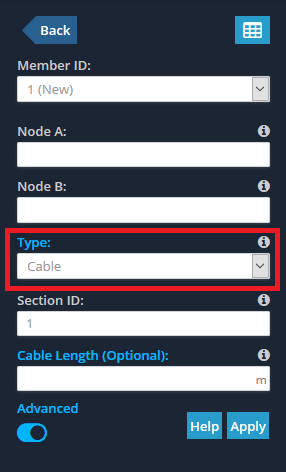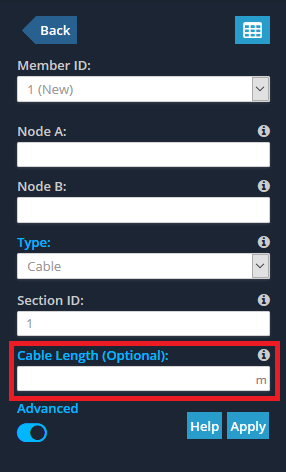File ManagerAccount SettingsAccessing The SoftwareSupportTeam ManagementFull Demos
Certification
Cables are a special type of member that can only be analyzed via a Non-Linear Analysis. Cables are tension-only and they often exhibit large displacements and non-linear behavior. They are never in compression and have zero flexural, torsional or shear capacity.
Cables are created in the same way as Members. Open the Advanced UI of the Member properties and simply select "Cable" as the Member Type as shown in the image below. It is important to note that when creating cables, you are effectively drawing the chord of the cable (i.e. a straight line joining Node A and Node B) rather than the catenary cable itself. The software will work out the catenary effects and sagging automatically, so there is NO need to create a series of smaller cable elements to represent the actual cable shape.

The software allows you to enter a cable length. If you enter a length that is less than the chord length (i.e. the distance between Node A and Node B of the cable member) then you can pre-stress the cable. Likewise if you enter a length that is larger than the chord length, the cable will be unstrained and sagging initially.
NOTE: Entering this field is OPTIONAL. If you do not specify a cable length then the initial chord length will be taken as the cable length (i.e. it is not pre-stressed and not sagging).

It is possible to enter a cable length that approximates a pretension force. We can do this using the formula for axial displacement:
[math] \begin{align} \Delta L &= \dfrac{P \overline{L}}{AE} \\ L - \overline{L} &= \dfrac{P \overline{L}}{AE} \\ P &= \dfrac{L - \overline{L}} { \overline{L}} AE \\ \end{align} [math] [math] \textsf{where: } \\ \begin{align} P &= \textsf{Pretension Force (i.e. the force in the cable)} \\ L &= \textsf{Original Length of the cable before tensioning (i.e. the chord length)} \\ \overline{L} &= \textsf{Length of the cable after pre-tensioning (entered into the field in the software)} \\ A &= \textsf{Area of the cross-section of the cable} \\ E &= \textsf{Young's Modulus of the Material used in the cable} \\ \end{align} [math]After the cable analysis runs the final axial force in the cable may be different to the force yielded by the formula above. This is because the force above is the "initial" force in the cable before the analysis takes place (i.e. the pretension). If you want to aim for a specific force in the cable at the end of the analysis then you may need to perform a series of iterations to get the intial pre-tension force correct.
Cables are special types of members that must be loaded according to the rules below:
Cables can be tricky to solve, so SkyCiv created a guide on some easy tips to solve a cable which features 5 things you can try to get your model to solve. In short, these include:
Otherwise, if you have a Professional Account our engineers can help via live support, where we can see your model in real-time.